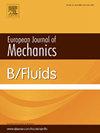带有胶体颗粒的液膜在垂直纤维上的涂布流动
IF 2.5
3区 工程技术
Q2 MECHANICS
引用次数: 0
摘要
研究考虑了胶体悬浮液薄膜在重力作用下在垂直圆柱体上向下扩散的问题。在三相接触线上采用了前驱膜模型来缓解应力奇异性。曲率压力导致在接触线处形成毛细管脊。假设液膜中存在块状胶体和表面胶体。界面形态由薄膜演化方程控制,该方程是通过简化润滑假设中的质量和动量平衡方程得到的,而体积浓度的平流-扩散方程则假设为快速垂直扩散。流体粘度和扩散率被认为是颗粒体积分数的函数。系统研究了大量胶体和表面胶体对铺展薄膜动力学的影响。对于较小的入口体积胶体浓度,体积胶体的存在会导致毛细管脊变薄。另一方面,较高的入口胶体浓度会在薄膜剖面的毛细管脊后面形成一个次级推进锋。随着上游胶体浓度的增加,接触点速度降低。由于溶质马兰戈尼应力的作用,发现表面浓度会在上游方向的毛细管脊后形成驼峰状结构。马兰戈尼应力还阻碍了表面张力驱动的扩散,导致接触线速度变小。降低邦德数会导致不稳定的薄膜剖面,从而在没有体积浓度梯度的区域形成波状结构。本文章由计算机程序翻译,如有差异,请以英文原文为准。
Coating flow of a liquid film with colloidal particles on a vertical fiber
A thin liquid film of colloidal suspension is considered which is spreading down on a vertical cylinder under the effect of gravity. A precursor film model is employed at the three-phase contact line to relieve the stress singularity. The curvature pressure leads to the formation of a capillary ridge at the contact-line. Bulk and surface colloids are assumed to be present in the liquid film. The interfacial pattern is governed by the film evolution equation, obtained by simplifying mass and momentum balance equations within the lubrication assumption, while rapid vertical diffusion is assumed for the advection–diffusion equation of the bulk concentration. Fluid viscosity and diffusivity are considered to be functions of the particle volume fraction. The effects of the bulk and surface colloids on the spreading film dynamics are systematically studied. The presence of bulk colloids leads to the thinning of the capillary ridge for smaller inlet bulk colloid concentrations. On the other hand, a larger inlet bulk concentration leads to the formation of a secondary advancing front behind the capillary ridge in the film profile. A reduced contact point velocity is observed with an increase in the upstream bulk concentration. Surface concentration is found to result in a hump-like structure behind the capillary ridge in the upstream direction due to solutal Marangoni stress. The Marangoni stress also hinders the surface-tension-driven spreading, resulting in a smaller contact line velocity. Reducing the Bond number results in unstable film profiles, which lead to a wave-like structure in the region with no bulk concentration gradients.
求助全文
通过发布文献求助,成功后即可免费获取论文全文。
去求助
来源期刊
CiteScore
5.90
自引率
3.80%
发文量
127
审稿时长
58 days
期刊介绍:
The European Journal of Mechanics - B/Fluids publishes papers in all fields of fluid mechanics. Although investigations in well-established areas are within the scope of the journal, recent developments and innovative ideas are particularly welcome. Theoretical, computational and experimental papers are equally welcome. Mathematical methods, be they deterministic or stochastic, analytical or numerical, will be accepted provided they serve to clarify some identifiable problems in fluid mechanics, and provided the significance of results is explained. Similarly, experimental papers must add physical insight in to the understanding of fluid mechanics.

 求助内容:
求助内容: 应助结果提醒方式:
应助结果提醒方式:


